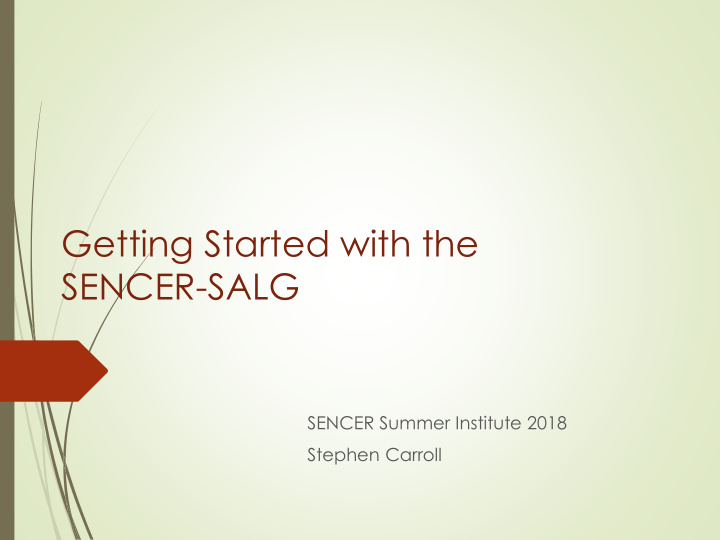



Getting Started with the SENCER-SALG SENCER Summer Institute 2018 Stephen Carroll
Evaluation of Teaching/Learning At nearly 80% of US colleges and universities, SETs (Student Evaluations of Teaching) are the primary means of evaluating teaching performance. At over 70% of US institutions of higher education, they are the only means of evaluating teaching.
Pair-Share Find a partner you haven’t worked with before and discuss these 2 questions: What value do you and your students get from student evaluations of teaching ? What would you like to get from your course evaluations? You have 4 minutes.
Challenges with SETs Almost all SETs focus primarily on teacher behavior and/or student satisfaction Neither teacher behavior nor student satisfaction are necessarily related to course goals – they are not good proxies for actual student learning SETs rarely provide information that helps teachers make specific improvements in their teaching or courses
Challenges with SETs The experience of filing out most student course evaluations offers little value to students SETs punish instructors who step outside of traditional gender roles Most SETs punish innovative teaching even when students recognize that it works!
Learning Assessment for Courses Student Assessment of their Learning Gains (SALG) Free Tools at www.salgsite. org
Why SALG? SALG was designed specifically to avoid the problems mentioned above SALG provides detailed , meaningful feedback to teachers about the value and efficacy of their teaching and guides improvements in teaching and learning SALG is based on learning research SALG was designed to promote metacognition in students
Why SALG? SALG protects teachers from career damage by SET instruments that focus on student satisfaction and have scant relevance to student learning gains SALG was created to promote and support thoughtful, effective teaching and its systematic, rational improvement SALG provides meaningful evidence of student learning that can be used to support cases for promotion and tenure
Why SALG? SALG is a valid, reliable instrument that has been in use and ongoing development since 1997 SALG is used by over 17,000 college and university instructors SALG is FREE! SALG is accepted as evidence of student learning by many accrediting bodies, including WASC
SALG Basic Principles You measure teaching effectiveness in terms of the specific stated goals of the course Students have something valuable to tell us about what they learned in our class and what helped them learn it (and what didn’t) Students should benefit from evaluating teaching: reflecting on their learning helps make them more conscious learners
SALG Structure 2 Main parts: - Learning goals (4 question sections) - Pedagogy (6 questions) The first 4 questions focus on learning goals : Understanding Skills Affective gains Integrations (or Habits) (Mnemonic= USA-1)
SALG Structure The second six questions focus on pedagogy : Course design Class activities Graded assignments Resources Meta-information Support for the individual learner
Validity & Flexibility The stem questions and the scales they use are fixed to preserve the validity and identity of the SALG (and to make it useful as a research instrument) But since evaluation always has to be in terms of stated goals and those goals are always specific, the SALG was designed to encourage instructors to adapt it specifically to their own courses . It remains valid after you adapt it to your course and learning goals
Customizing your SALG
SALG Scheduling Baseline survey near the beginning of the term assesses students’ current level of achievement in relation to course learning goals SALG survey at the end of the term measures learning gains (improvements relative to course learning goals) Can also run SALG surveys as mid- term surveys
Analytical Capabilities Detailed statistics about student responses: N, Mean, Std Dev, Mode, # at Mode, etc. Histograms for each question set Aggregated statistics for multiple instruments Cross-tabs Simple text coding for qualitative analysis Entire analysis can be downloaded into Excel
English 179 Learning Objectives Think rhetorically about any and all types of business communications and develop appropriate communications strategies based on your analyses Communicate effectively with all relevant business audiences in a variety of contexts, deliberately varying style, tone, arguments and means of communication as appropriate Write logically structured, comprehensible documents Write clear, concise prose using appropriate formats, and following contemporary, context-appropriate rules of grammar and usage Speak appropriately and effectively to individuals and small groups in a variety of contexts with differing degrees of formality Collaborate effectively in group problem-solving and document production (even when you are not able to meet face-to-face) Exhibit good judgment by making well-considered and helpful decisions even when guidance and available resources are inadequate or unhelpful Control all facets of your ethos strategically and effectively in all public and business interactions
Department SALG Department admin can make templates with locked questions related to departmental learning goals Faculty using templates cannot modify locked questions, but can control everything else After the survey, department admin gets data for locked questions only ; instructors get all data back
Inspiration What Teachers Make
Thank You ! www.salgsite.org scarroll@scu.edu
Recommend
More recommend